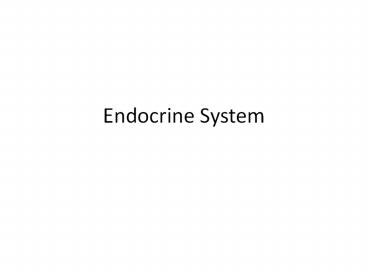Endocrine System - PowerPoint PPT Presentation
1 / 19
Title:
Endocrine System
Description:
... into the bloodstreamand travels to target cells Ex. Suckling stimulates hypothalamus then trigger oxytocin from pituitary gland Negative vs ... – PowerPoint PPT presentation
Number of Views:101
Avg rating:3.0/5.0
Title: Endocrine System
1
Endocrine System
2
I. Endocrine system
- A. Endocrine tissues organs are found
throughout the body some along organs part of
other systems others found along glands - B. Hormones are the molecules that are secreted
by this system into extracellular fluid,
circulate in the blood and communicate regulatory
messages throughout the body. - 1. Each hormone has specific receptors in the
body that can regulate reproduction, development,
metabolism, growth behavior
3
(No Transcript)
4
II. Intercellular Communication
- A. There are 2 main criteria that classify how
signals are transmitted between cells the type
of secreting cell the route taken by the signal
in reaching its target.
5
- 1. Endocrine Signaling hormones secreted into
extracellular fluid by endocrine cells reach
target by flowing through blood stream
6
- 2. Local regulators secrete molecules that act
over short distances reach target cells solely
by diffusion. - Ex. Paracrine signaling target cells that lie
near secreting cell - Autocrine signaling cells are the secreted
cell itself
7
- 3. Synaptic Neuroendocrine Signaling allow
for signaling through nervous system by neurons - a. Neurotransmitters signaling at synapses
- b. Neurohormones molecules that are secreted by
special neurons into the bloodstream (Ex. ADH)
8
- 4. Pheromones chemicals released into the
external environment - a. commination within own species
9
III. Classes of Hormones
- A. Hormones vary by size chemical properties
since there are 3 chemical classes of hormones
including - 1. Polypeptides 2 polypeptides chains (insulin)
- 2. Steroids composed of lipids, 4 fused carbon
rings (cortisol) - 3. Amines one single amino acid
(tyrosine/trptophan) - B. The chemical make-up of the hormone explains
how the hormone targets the cell polypeptides
amines are water soluble so they can not pass
through the cell membrane unlike steroids that
are lipid soluble
10
(No Transcript)
11
(No Transcript)
12
IV. Cellular Response Pathways
- A. How a hormone causes a response are different
between water-soluble lipid-soluble hormones. - 1. Water-soluble hormones are secreted by
exocytosis travel through the blood stream
bind to cell-surface protein receptors. - a. can cause changes in transcription by signal
transduction (extracellular chemical causing
intercellular response) Ex. epinephrine
13
- 2. Lipid-soluble hormones diffuse out across a
membrane of endocrine cells, they bind to
transport proteins that keep them soluble in the
blood stream and then diffuse into target cells - a. change in gene expression
14
V. Effects of Hormones
- A. Hormones can cause more than one type of
response in your body since target cells can vary
in their response to a particular molecule with
different receptors. - 1. Epinepherine mediating bodys response to
stress - Triggers glycogen breakdown in liver
- Increased blood flow to major skeletal muscles
- Decreased blood flow to digestive tract
15
(No Transcript)
16
VI. Signaling by Local Regulators
- A. There are several chemical compounds function
as local regulators (Paracrine Autocrine) - 1. Growth factor stimulate cell proliferation
- 2. Nitric oxide helps regulate the oxygen
levels by activating enzymes that relax muscles - 3. Prostaglandins stimulate muscle contraction
in the uterus, promote fever inflammation,
blood clotting
17
VII. Regulatory Pathways
- A. Two basic types of organization
- 1. Simple endocrine pathway endocrine cells
respond directly to internal or environment
stimulus by secreting a hormone into blood stream - Ex. Stomach contents enter duodenum - pancrease
- 2. Simple neuroendocrine pathway stimulates is
received by sensory neuron, stimulates
neurosecretory cell then secretes a neurohormone
which diffuses into the bloodstreamand travels to
target cells - Ex. Suckling stimulates hypothalamus then trigger
oxytocin from pituitary gland
18
Negative vs. Positive
19
IIX. Control of Blood Glucose
- A. Controlled by 2 antagonistic hormones that
operate in a simple endocrine pathway regulated
by negative feedback - 1. Insulin triggers uptake of glucose from the
blood, slows down glycogen breakdown - 2. Glucagon promotes the release of glucose
into the blood from energy stores, such as liver
glycogen, - B. Both are released by the pancreas into the
circulatory system - Alpha cells make glucagon
- Beta cells make insulin
- Diabetes mellitus deficiency of insulin or a
decreased response to insulin in target cells.
Fat becomes main energy source acidic
metabolites form lowering blood pH































